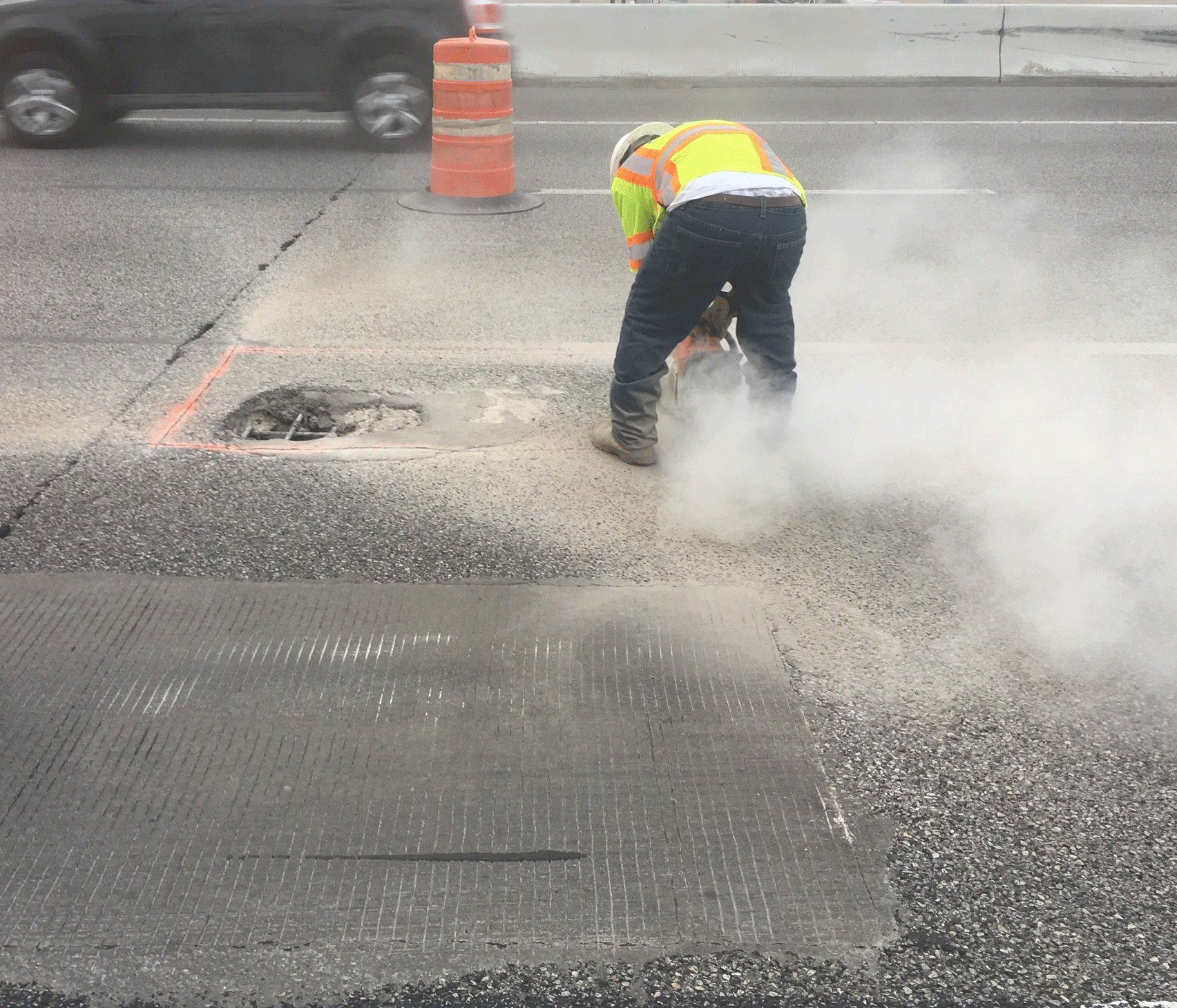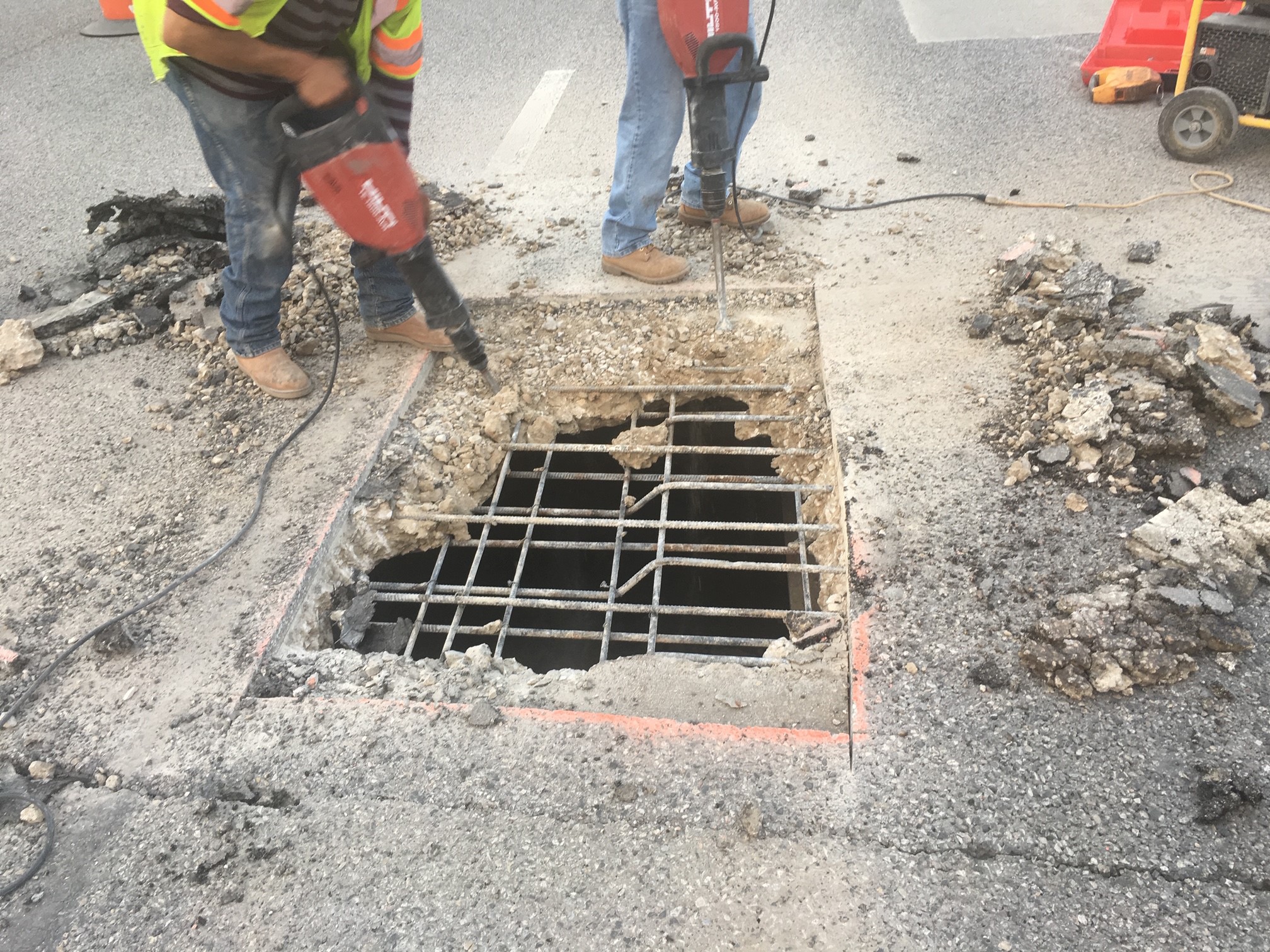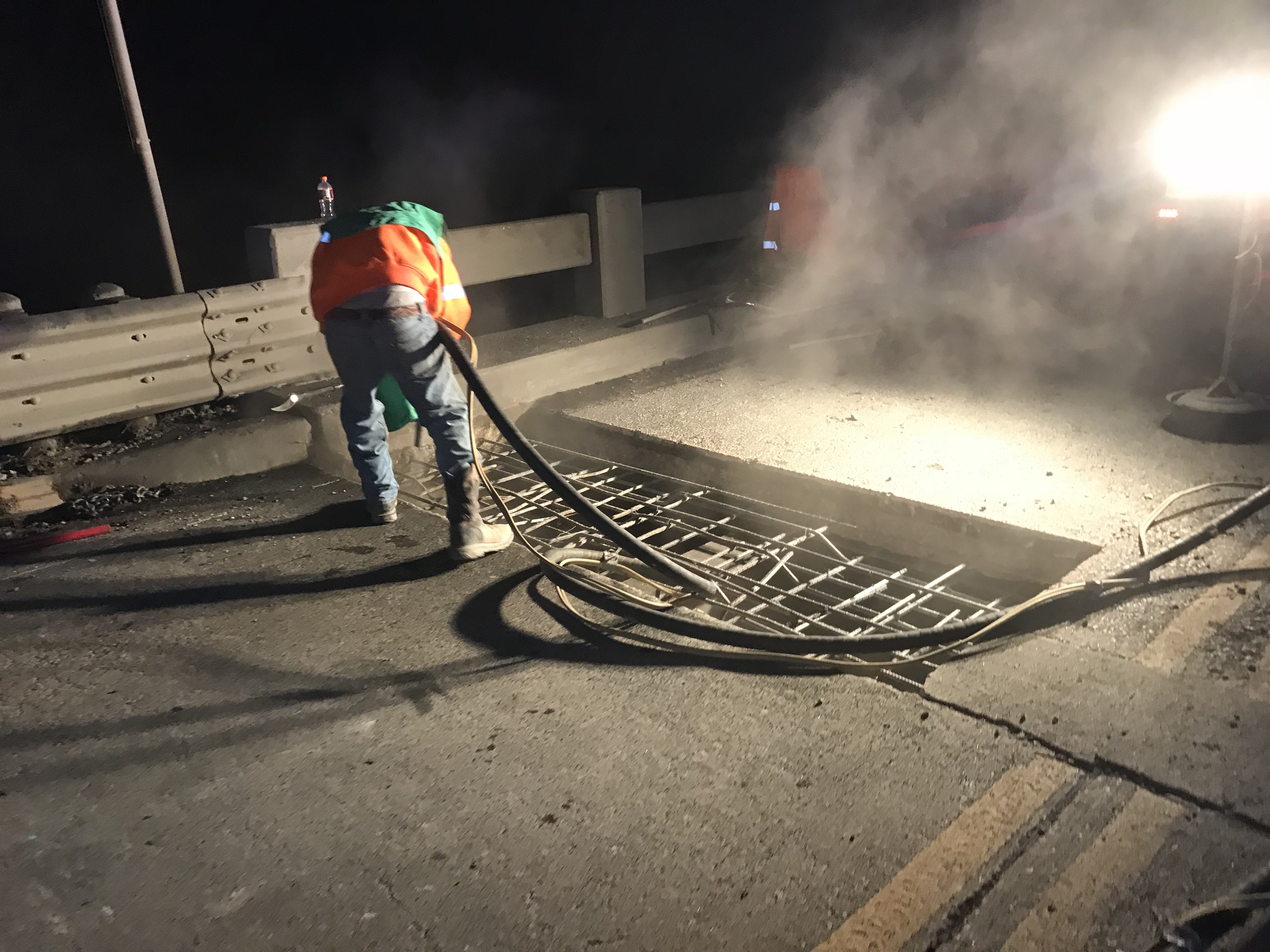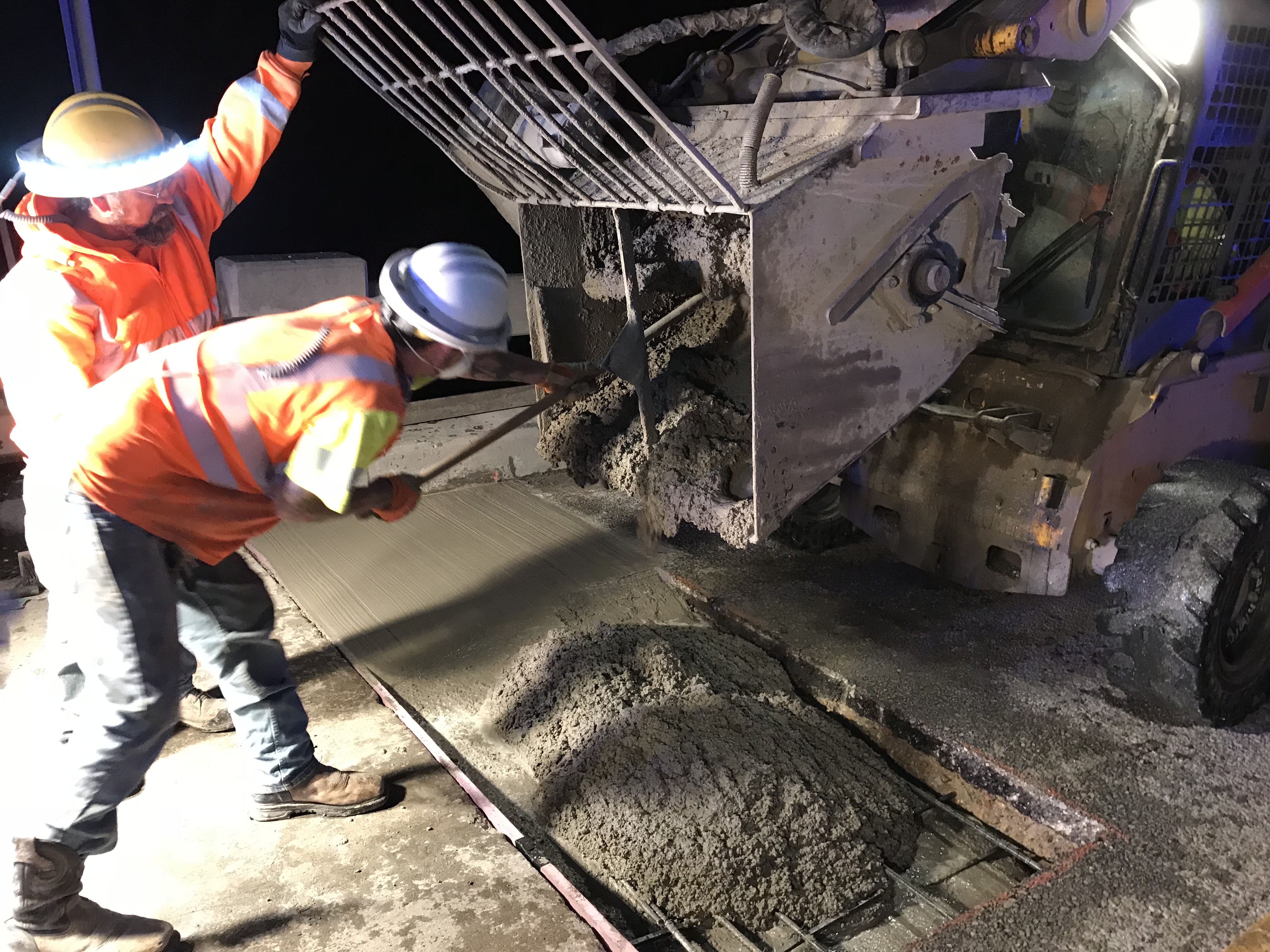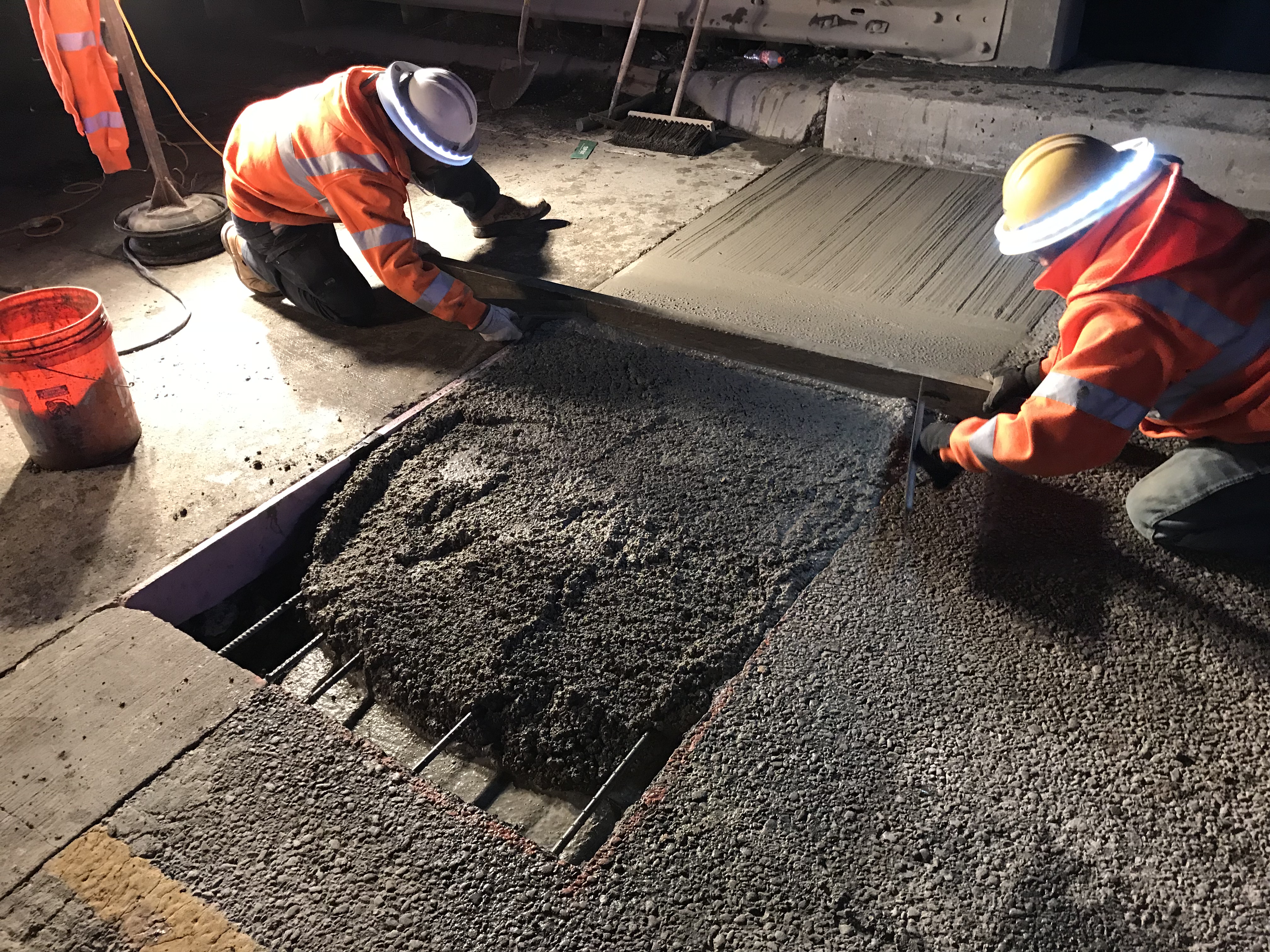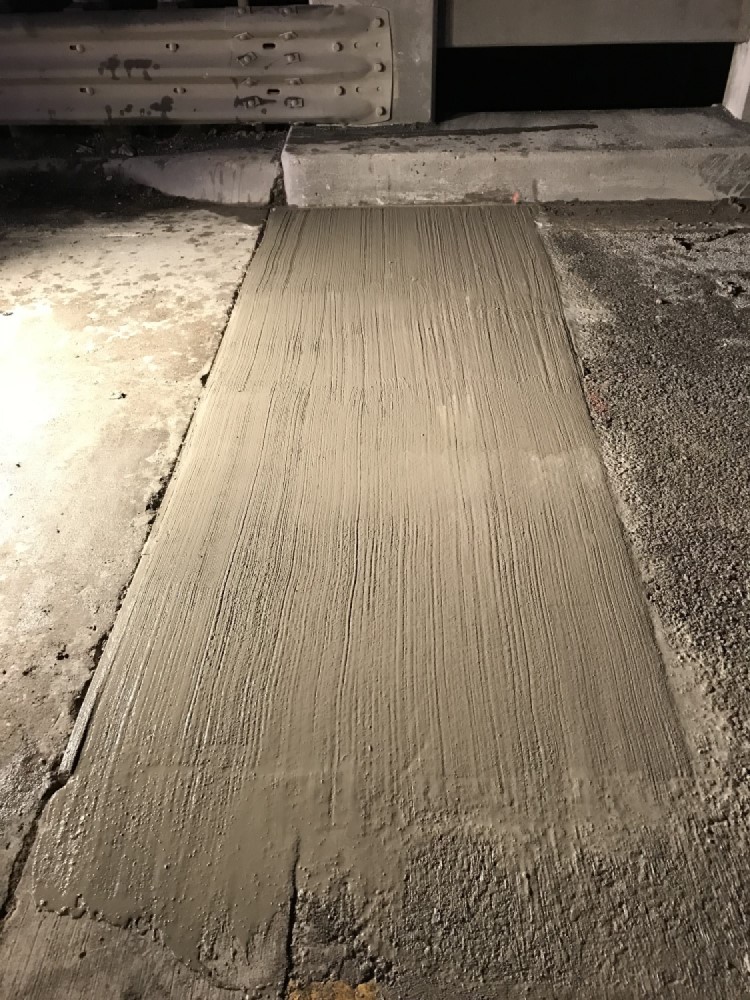Section 4: Bridge Deck Repair
Anchor: #i1004033Description
This section covers bridge deck repairs over relatively small areas. Large-scale deck repair or replacement work should typically include project-specific plans and be in accordance with Item 422, “Concrete Superstructures.” The primary use of this section is to address unanticipated localized bridge deck damage that typically must be repaired quickly.
The work covered here can be categorized in two ways. First, by depth: (1) partial depth deck repairs, (2) deck repair over precast deck panels (PCP), and (3) full-depth bridge deck repair. Second, by speed: (1) ultra-rapid, (2) rapid, (3) accelerated, and (4) normal.
- Anchor: #RCOUVGHR
- Defining Bridge Deck Repairs by
Depth:
- Anchor: #FPKBNAQC
- Partial-depth bridge deck repairs are typically performed on full-depth cast-in-place bridge decks. Damage in the top of the deck only (not progressing full depth) is due to initial slab defects such as improper consolidation or insufficient concrete clear cover over the reinforcing steel; abrasion; wear; or top reinforcing mat steel corrosion. Anchor: #CGJWSXUI
- Distress can also occur in the cast-in-place sections of deck above precast concrete panels (PCP’s). Regardless of the severity, when performing deck repairs in such cases the cast-in-place portion should be removed to expose the top of the PCP, which then becomes the bonding interface for the repair material. When spalling is occurring above a precast panel, the underside of the panel should be checked for distress. If there is substantial staining on the girder side faces indicating roadway drainage passing through the haunch concrete, panels likely should be replaced with a full depth repair. Anchor: #FIWIYOWH
- When damage extends into the PCP portion of the deck, exhibited by visible cracking on the panel soffit, then it should be treated as a full-depth deck repair. Anchor: #VGSLYRTO
- Full depth repairs are typically performed when partial depth distress has gone untreated and has progressed to full depth distress as discussed in the commentary of this section and when required to perform expansion joint replacement.
Anchor: #FGOTCUPQ - Defining Bridge Deck Repairs by Speed
(Required Return to Service):
- Anchor: #LITMXYVH
- Often, the factor that trumps all others in bridge deck repair work is the need to return a structure to service quickly. Bridge deck failures and consequent lane closures can have hugely detrimental impacts on traffic, particularly in urban environments. Over the years, repair material suppliers and contractors have become accustomed to the need for extraordinarily quick turnaround, and have catered their services around that need. However, it has been observed that re-repair of previously repaired decks occurs frequently when the rapid strength gaining materials are used. This is further expanded upon in the commentary of this section. Anchor: #VEVLUHBG
- In this section there are four categories of repair material based on the needed return to service time. Ultra-rapid repair material can attain sufficient compressive strength for return to service in 2 to 4 hours. Rapid repair materials can generally be returned to service in 6 to 8 hours. Class K material is batched concrete designed specifically in deck repair applications for accelerated strength gain and return to service, usually in less than 12 hours (not including moist curing time). Class S concrete is the best long term solution but can take several days to achieve sufficient strength. Follow the plan requirements related to required strength prior to opening to traffic. If no guidance is provided, provide concrete able to obtain a minimum of 3,600 psi compressive strength prior to opening to traffic.
Selecting an Appropriate Repair Material
An appropriate repair material can be selected once a project has been categorized based on the needed return to service. For depths exceeding 3 inches use material extended with coarse aggregate.
- Anchor: #RTXUSKMU
- 3 hours: Use a preapproved Type B Ultra-Rapid Repair Material meeting the requirements of DMS 4655, Concrete Repair Materials. Anchor: #KAYLKMCF
- 6 hours: Use a preapproved Type A Rapid Repair Material meeting the requirements of DMS 4655, Concrete Repair Materials. Anchor: #XEAWFHHA
- 24 hours: Use Class K concrete. These are typically specialty mix designs supplied by a Ready-Mix plant. Mix design requires review and approval from the Engineer. Depending on the capabilities of local Ready-Mix plants this option may or may not be available. Anchor: #PGQFPFWB
- 2 to 4 days: Class S concrete mixes, which are used to cast new bridge decks, offer the best likelihood of long term serviceability. However, it can take several days before the concrete has sufficient strength for return to service. Engineer should review the history of the proposed Class S mix to ensure that relatively fast strength gain (less than 4 days) is likely to occur. Even with rapid strength gain, Class S mixes should be moist cured for 72 hours (absolute minimum 48 hours).
For batched concrete, provide mixes meeting the requirements of Item 421, Hydraulic Cement Concrete. Note that typical Class HES mixes may not be classified as structural concrete, and should not be used, unless otherwise approved.
Anchor: #i1004152Repair Procedure
- Anchor: #AKTLMGTE
- Mixing.
- Anchor: #YEXVLTLD
- Except in very small applications (less than 1 cubic yard), use a mortar or volumetric mixer. Ready-Mix suppliers and trucks should typically provide batched concrete (Class K or Class S), though the Engineer may approve volumetric mixers on a case-by-case basis. Anchor: #VFJBEQAJ
- For small applications (less than 1 cubic yard total), mix the components thoroughly by mechanical means (electric drill or mortar mixer) per the manufacturer's requirements. Do not mix repair material by hand. Anchor: #AUJYNWNS
- Regardless of the mixer type, carefully
proportion the water to ensure water-to-cement ratio falls within
manufacturer limits. Do not guess at proper quantities or add water
to attain a desired consistency.
NOTE: Contractors often use “5-gallon” buckets to proportion water. The actual volumes of these buckets can vary significantly. The Contractor and Inspector should verify actual volumes rather than assuming the buckets actually hold exactly 5 gallons.
Anchor: #RGBDAENR - Do not mix material until surface preparation is complete. Ensure that there are sufficient amounts of material, mixing equipment, and labor to provide a continuous supply of mixed concrete until the placement is complete. Take sufficient steps to prevent cold joints between lifts, keeping in mind that many proprietary materials set up very rapidly (less than 15 minutes) in hot weather.
Anchor: #VTHMLVLF - Removal of Concrete.
-
Anchor: #OIXVQTCR
- Saw-cut the perimeter of the proposed repair approximately 1/2 to 3/4 inches but do not cut existing reinforcing steel. Adjust depth as necessary to avoid damaging deck steel. Anchor: #OUHLROQV
- Use power-driven chipping tools or hydro-demolition equipment to remove concrete. Avoid damage to sound concrete to remain. Contractor may use up to 30-lb. hammers for the bulk of the work. However, 15-lb. hammers or smaller must be used at the base and perimeter of the repair area to avoid damaging the surrounding concrete. Anchor: #JPTNDJHY
- Remove additional concrete as necessary to keep the repair area to a reasonably uniform depth. Anchor: #MDYMITCJ
- Partial-Depth Deck Repair
-
Anchor: #MEGQMILR
- Remove a sufficient amount of damaged concrete to ensure that the remaining deck is sound. Provide a uniformly rough surface with a chipped appearance (1/4 inch minimum surface profile or ICRI Concrete Surface Profile 9). Anchor: #ACUCLRWJ
- Even if defective material does not extend beyond top layer of reinforcement, remove enough concrete to ensure there is minimum ¾ inch clearance below the top layer of steel in order to provide mechanical bond for new patch material.
Anchor: #KOEUYOVI - Repairs over precast deck panels (PCPs): Completely remove cast-in-place concrete to expose roughened PCP surface. Ensure that demolition operations do not damage the PCPs. Anchor: #QVUHNHKQ
- Full-Depth Deck Repair: Square or slightly undercut the repair perimeter. Anchor: #FNKKQCSB
- The Engineer or the Inspector may sound the perimeter of the repair area to determine whether concrete removal operations caused damage beyond the intended perimeter. If that is the case the repair area must be extended to include the unintentionally damaged area. Anchor: #NNDUEYQD
- For full-depth repairs, remove the concrete and place forms in accordance with Item 422, Concrete Superstructures, or as approved by the Engineer. Anchor: #WQOXANYH
- Obtain approval from the Engineer of the completed concrete removal before proceeding with surface preparation.
Anchor: #YEOOIYPG - Reinforcing Steel.
-
Anchor: #NCURXLKE
- Remove all rust and other deleterious material from reinforcing steel. Anchor: #RLCEBFTY
- For non-epoxy coated reinforcing and for epoxy coated steel bars with coating failure, abrasive blast clean steel. Inspect cleaned steel for damage. Replace bars when cross-section is reduced greater than 25 percent. Anchor: #JKCWDEUJ
- Apply an approved epoxy coating to repair minor damage to existing epoxy coated bars. Anchor: #HXQCJVIB
- When the original epoxy coating on the bars was removed by abrasive blasting, apply an epoxy coat around the entire circumference of the bars extending a minimum of 3 inches from the repair perimeter into the repair area. Anchor: #DDCAQFRS
- Install reinforcing steel as indicated on the plans or as directed by the Engineer. Place reinforcement parallel to the finished surface. Lap adjacent sheets or bars at least 6 inches and tie them together securely at a spacing of at most 18 inches. Anchor: #QLPDKRCO
- Pre-bend reinforcing steel fabric to fit around corners and into re-entrant angles before installing it. Place and secure reinforcement to prevent displacement due to repair material application.
Anchor: #BUQEMWRC - Surface Preparation.
-
Anchor: #FOHYDTIQ
- Just prior to repairing, thoroughly clean the concrete surfaces (bottom and sides). Anchor: #VNRNURCU
- Clean the area to be repaired by high-pressure water blasting, or other approved methods. Remove all loose particles, dirt, deteriorated concrete, or other substances that would impair the bond of the repair material. Follow this with a high-pressure air blast for final cleaning. Anchor: #WDCUJTWV
- Ensure the surface of the existing concrete is in a saturated surface-dry (SSD) condition but remove all free (ponded) water just before placing repair material. Achieve an SSD condition by high-pressure water blasting at least 15 minutes before placing the repair material.
Anchor: #UPBWHEGF - Formwork.
-
Anchor: #MIDCVCVY
- Formwork should be tight to prevent leakage of grout or mortar. Anchor: #PIFXROES
- Formwork surfaces should not be too hot, preferably not higher than 90°F, to avoid flash set of fresh concrete.
Anchor: #PGIMUFHN - Placement.
- Anchor: #YXMNXYGS
- Place the repair material onto the prepared surfaces. Consolidate using immersion-type vibrators or other methods acceptable to the Engineer.
Anchor: #HVSQXLDM - Curing.
Moist curing is often neglected in deck repairs due to the need to return the bridge to service quickly. However, lack of adequate curing leads to problems on deck repair materials just as it does on any other cementitious repair. Bridge deck repairs should be moist cured for as long as possible. Although 72 hours of curing time is ideal, that is seldom practical in deck repair applications. Even a few hours of moist curing can be beneficial.
Steps for full-depth deck repair
-
Anchor: #EEEVICNN
- Define repair boundary areas
-
Anchor: #GCAKRHJP
- Sound the concrete to determine the boundary of repair area. Anchor: #MVQTMJHV
- Typically add 3 in. in both directions unless otherwise noted on plans. Anchor: #CRTKJSDH
- Delineate straight edges for repairs.
Anchor: #BCSOVSOT - Saw cut the repair boundary
repair boundary areas
- Anchor: #UYSSAIWG
- Square or slightly undercut the repair perimeter. Anchor: #NBHELVHB
- Do not cut reinforcement steel
Anchor: #HOIYLSGS - Remove deteriorated/unsound
concrete
- Anchor: #KHLEOPJG
- Use power-driven chipping tools or hydro-demolition equipment to remove concrete. Avoid damage to sound concrete to remain. Contractor may use up to 30-lb. hammers for the bulk of the work. However, 15-lb. hammers or smaller must be used at the base and perimeter of the repair area to avoid damaging the surrounding concrete.
Anchor: #UYBLDGCG - Installation of formwork
-
Anchor: #JWNBEKHW
- Formwork should be tight to prevent leakage of repair material.
Anchor: #PJDUFAHQ - Prepare repair area
-
Anchor: #RCDUYMCS
- Clean the area to be repaired by high-pressure water blasting, or other approved methods. Anchor: #MXYMCROV
- Use abrasive blasting to remove rust from exposed steel surfaces. Anchor: #REDTHEJX
- Remove all loose particles, dirt, deteriorated concrete, or other substances that would impair the bond of the repair material. Follow this with a high-pressure air blast for final cleaning.
Anchor: #QBYAQJVL - Mixing
-
Anchor: #DUDNELUJ
- Prepare repair material in accordance with the approved methods for batching concrete.
Anchor: #QYIUGWLC - Place and finish concrete
-
Anchor: #UYOWPTRS
- Place the repair material onto the prepared surfaces. Consolidate using immersion-type vibrators or other methods acceptable to the Engineer. Anchor: #CPJPBNPJ
- Distribute the concrete evenly to avoid the need of excessive shoving. Use vertical penetrations of an approved vibrator to adequately consolidate the concrete. Do not drag the vibrator through the mix as this may cause segregation and loss of entrained air.
Anchor: #XXUREXFC - Cure and insulate concrete
-
Anchor: #WXUOKBPF
- Curing is important to help the concrete achieve intended strength and durability.
Figure 3-9. Saw-cutting along defined repair boundaries
Figure 3-10. Remove deteriorated/unsound concrete
Figure 3-11. Installation of formwork
Figure 3-12. Repair area preparation (high-pressure water blasting, or other approved methods to remove dust and debris. Abrasive blasting to remove rust from exposed steel surfaces)
Figure 3-13. Placing the concrete
Figure 3-14. Finishing the concrete
Figure 3-15. Cure and insulate concrete
- Define repair boundary areas
Commentary
Shallow deck repairs are notorious for exhibiting poor performance. One common cause of early failure is debonding between the repair material and the substrate. Repair material applied over large areas but in thin applications tend to build up very high stresses at the bond line, leading to premature failure. To remedy this the Contractor should excavate below the top layer of steel, which serves two purposes. First, the reinforcing cage provides a mechanical tie for the repair material to the rest of the deck. Second, it helps to prevent overly thin applications that have little chance of performing well.
Another common cause of premature failure is that partial-depth repairs are often implemented when full-depth would have been more appropriate. The deck soffit should be inspected at partial depth repair locations looking for areas of distress that could be weak and fail when the upper surface is being removed. Partial-depth repairs are typically easier to perform because they do not require installation of formwork or road closures under the bridge. Bridge deck distress oftentimes progresses full depth, as evidenced by cracking in the deck soffit. If map pattern cracking is visible, or if there is widespread cracking with efflorescence and rust staining, then full depth repairs should usually be implemented in lieu of partial-depth.
Intended partial-depth deck repairs can unintentionally become full-depth repairs if the Contractor utilizes equipment too heavy for the application. Contractors should not use equipment larger than necessary to perform the required demolition work, and must stay within the applicable limits outlined in the “Surface Preparation” item below, unless specifically allowed otherwise by the Engineer. No additional compensation for full depth repairs caused by contractors operations will be made.
While rapid strength gain is beneficial for returning a bridge to service, it typically has detrimental effects for the repair material. Short duration curing of the cementitious material can prevent even distribution of the hydration products. Also, early return of service induces stresses into concrete that can create microcracking and other defects even when the compressive strength is high.
Because deck repairs must usually be performed quickly, Engineers and Contractors often select rapid methods even when they are not necessary. It is imperative that, when feasible, slower-hydrating materials and longer curing cycles be utilized. The faster the return to service, the shorter the anticipated service life of the repair.
